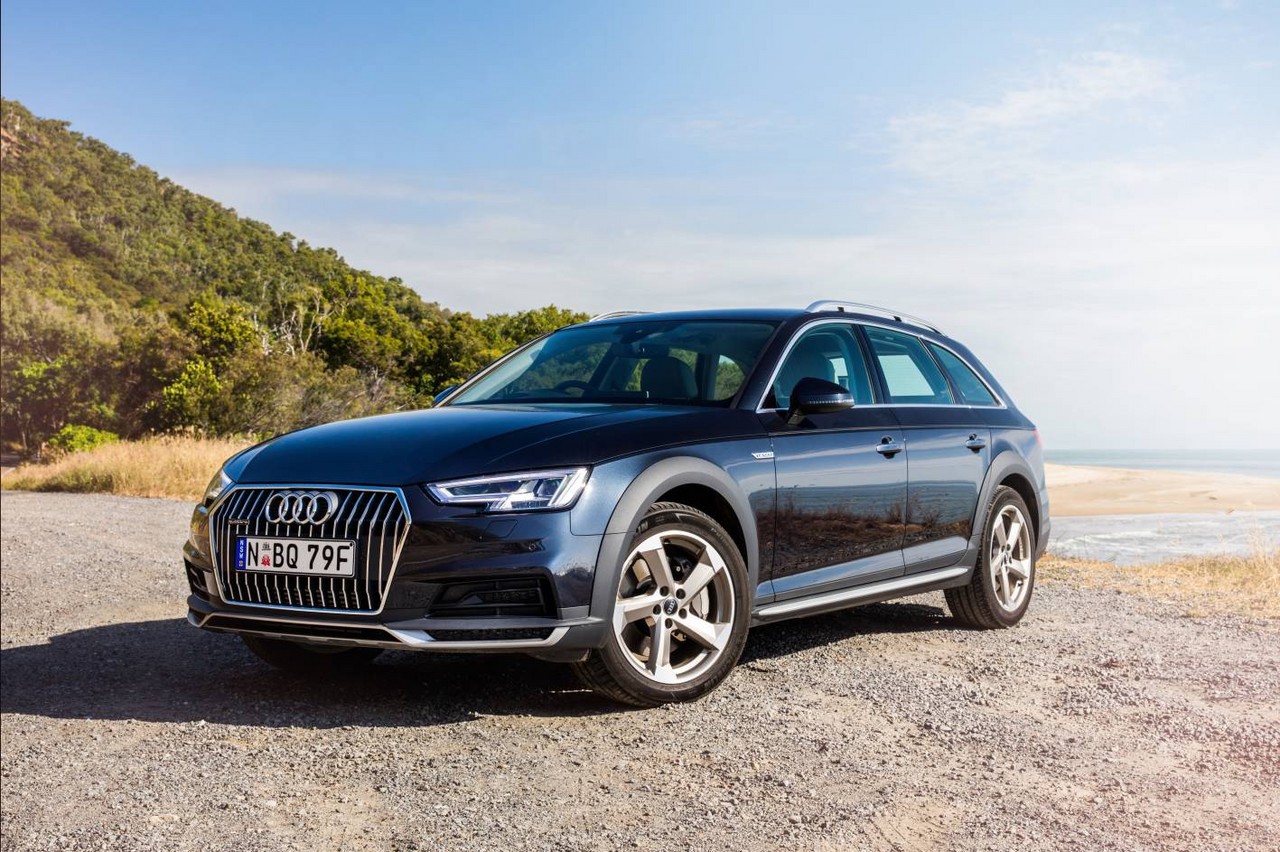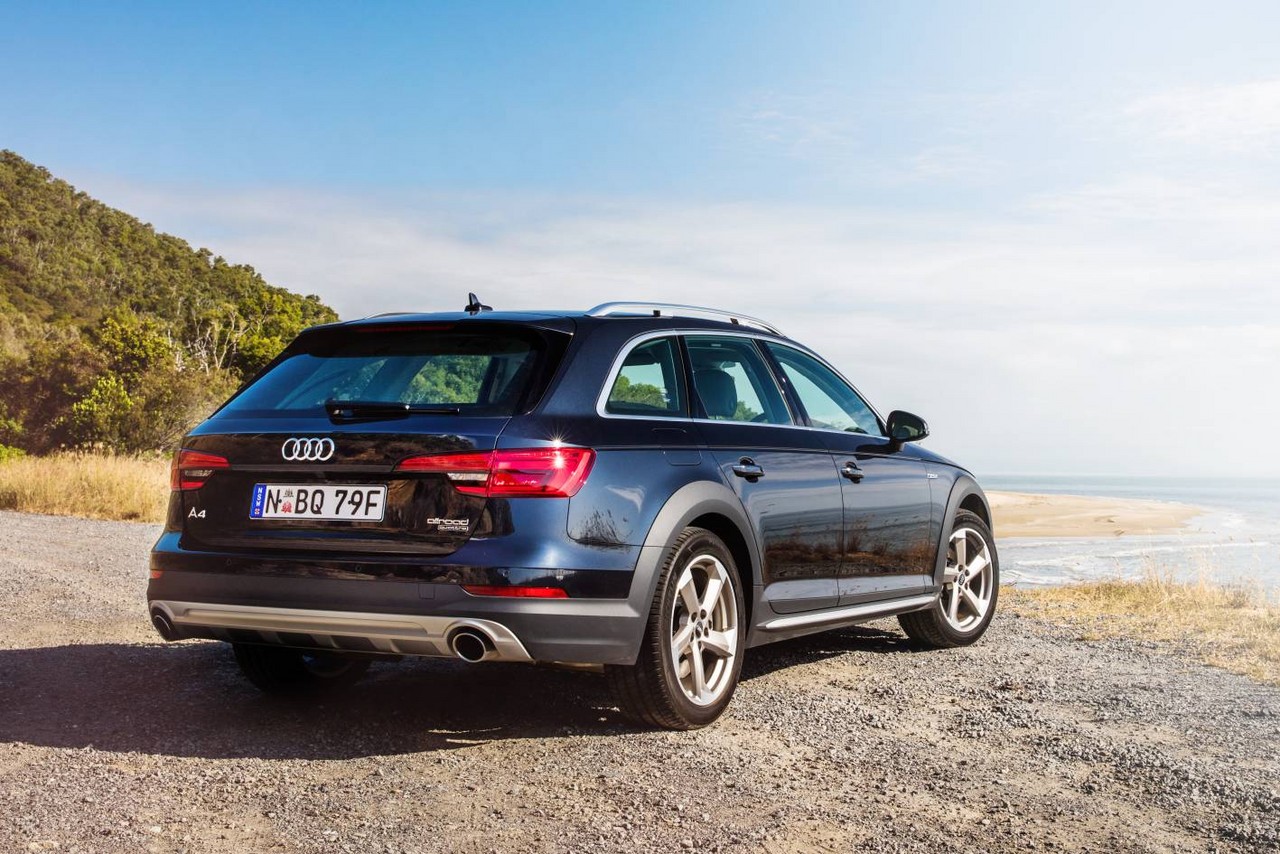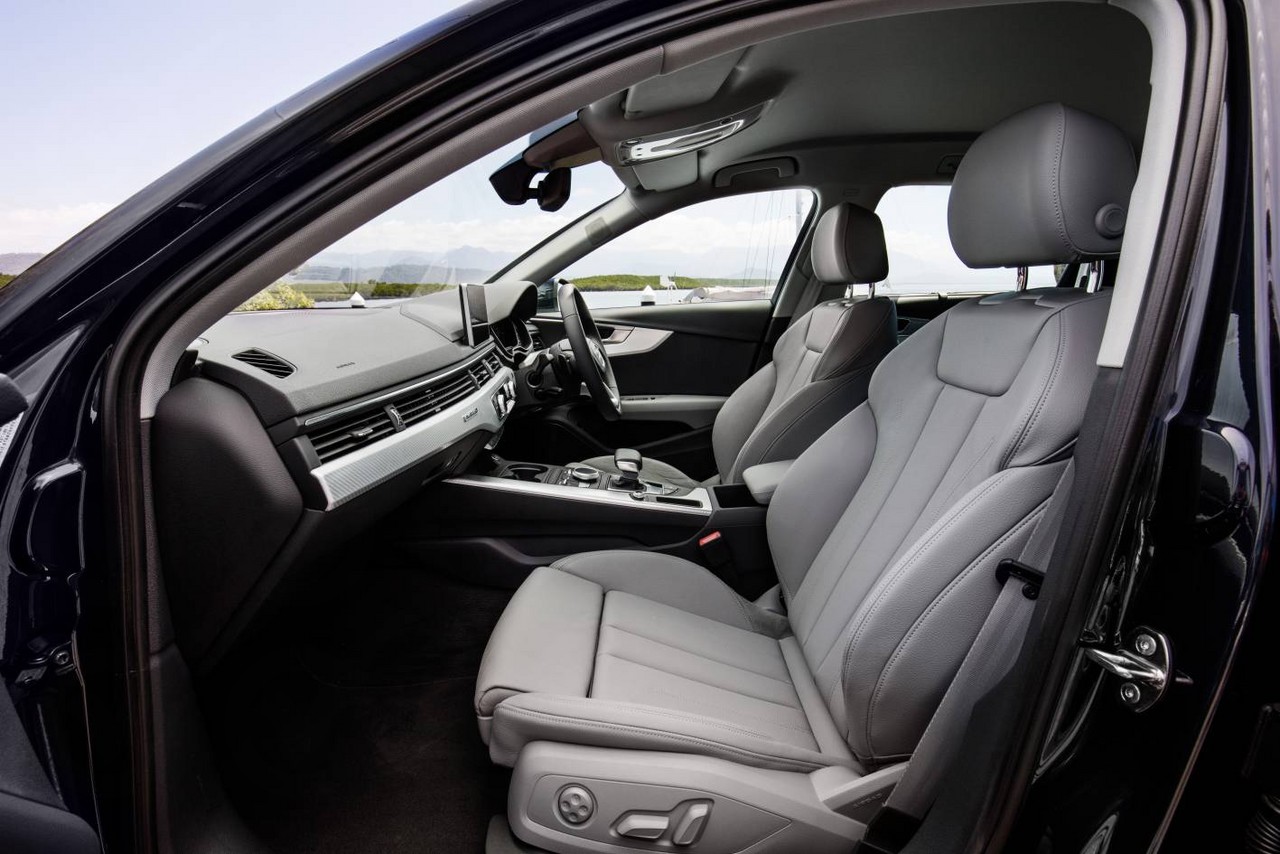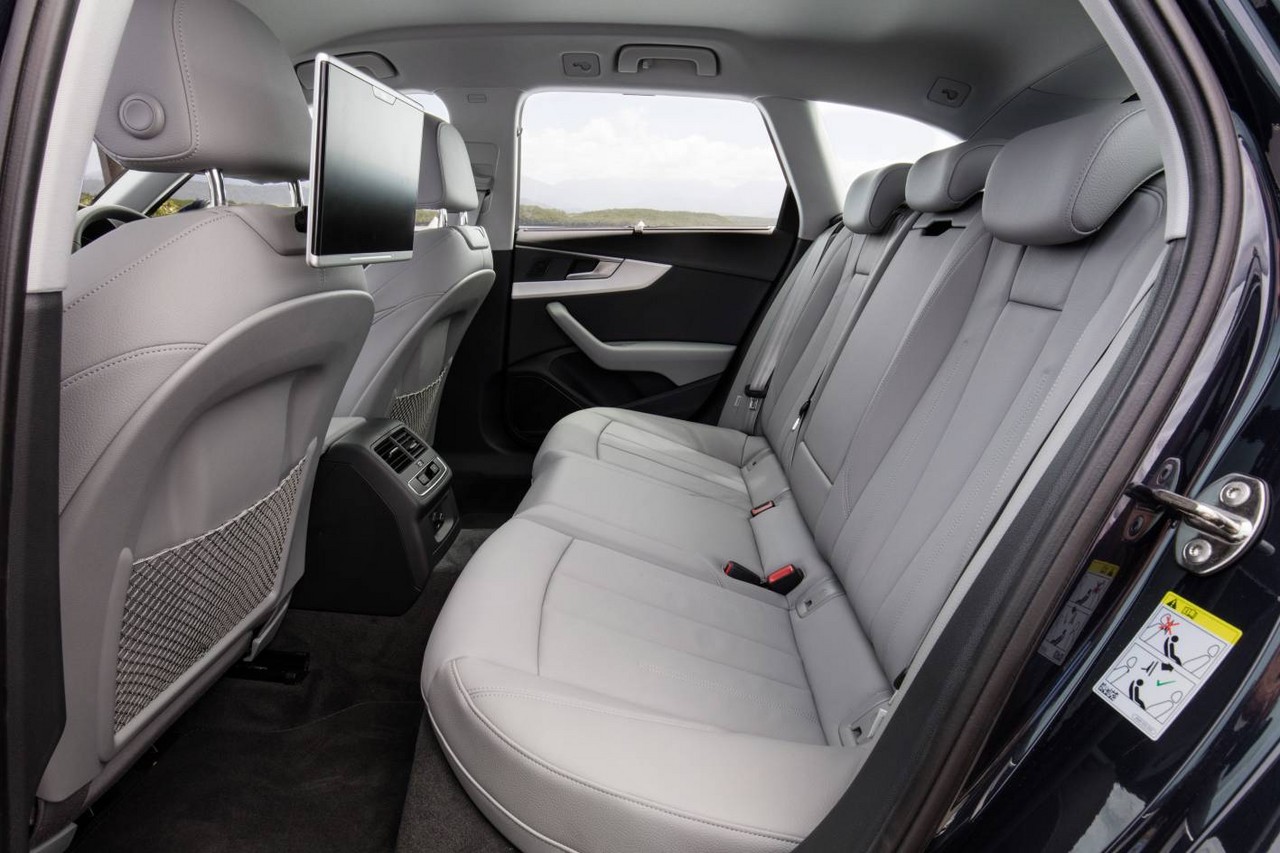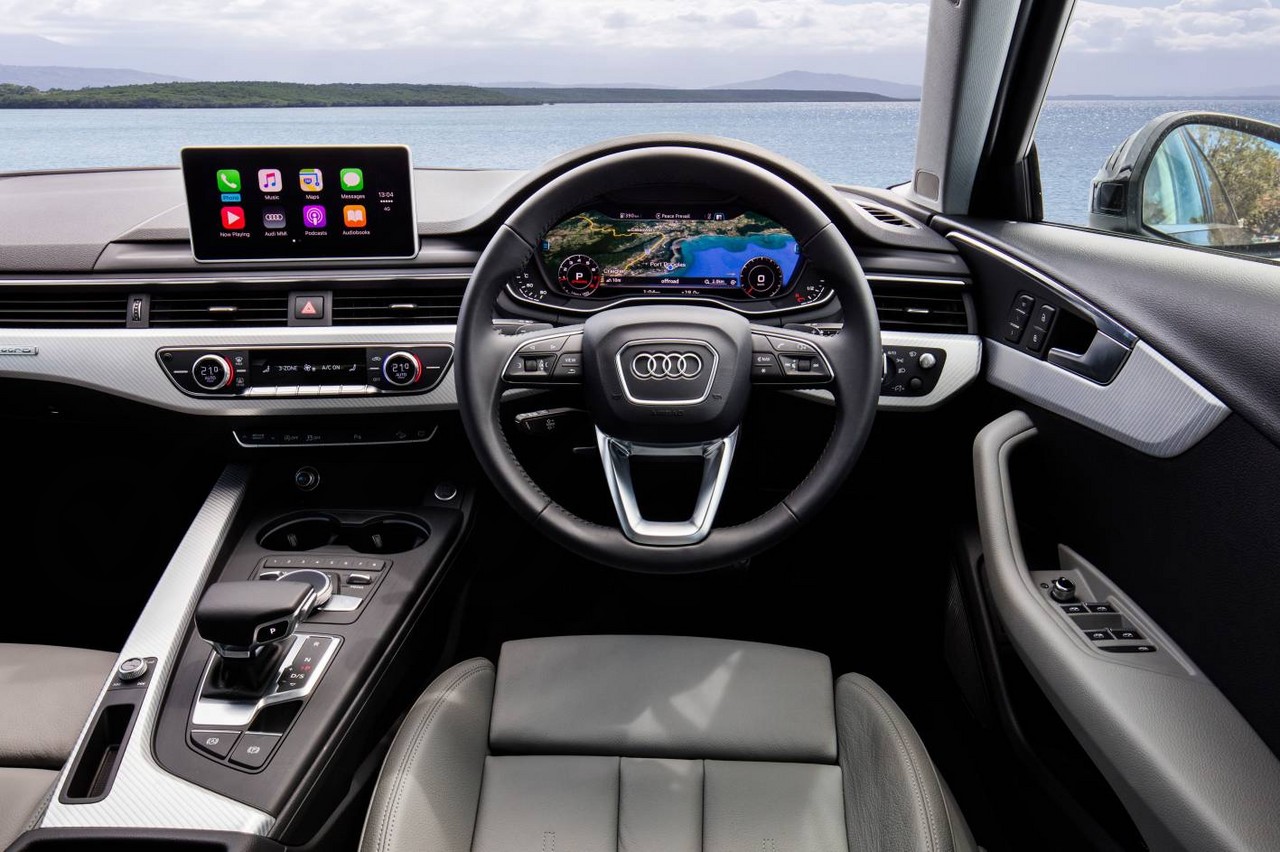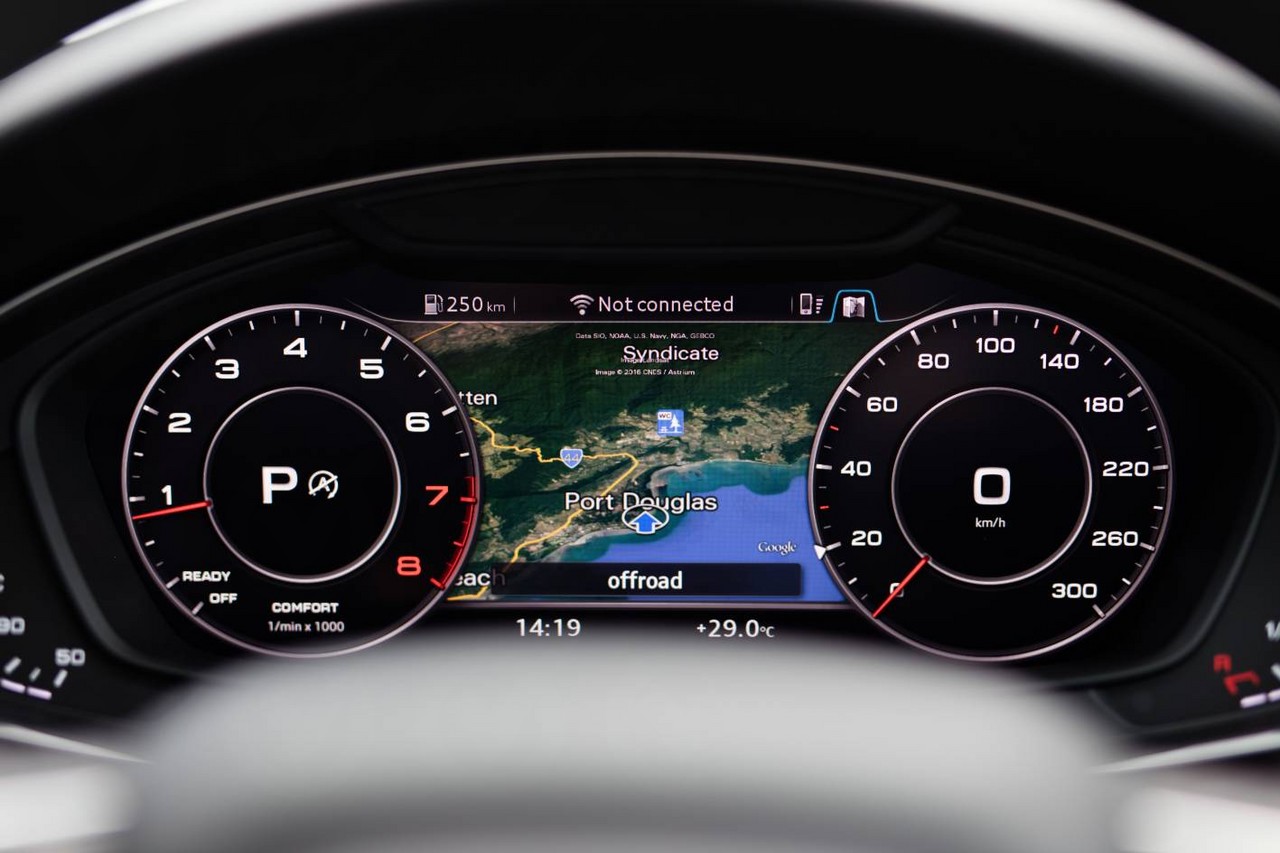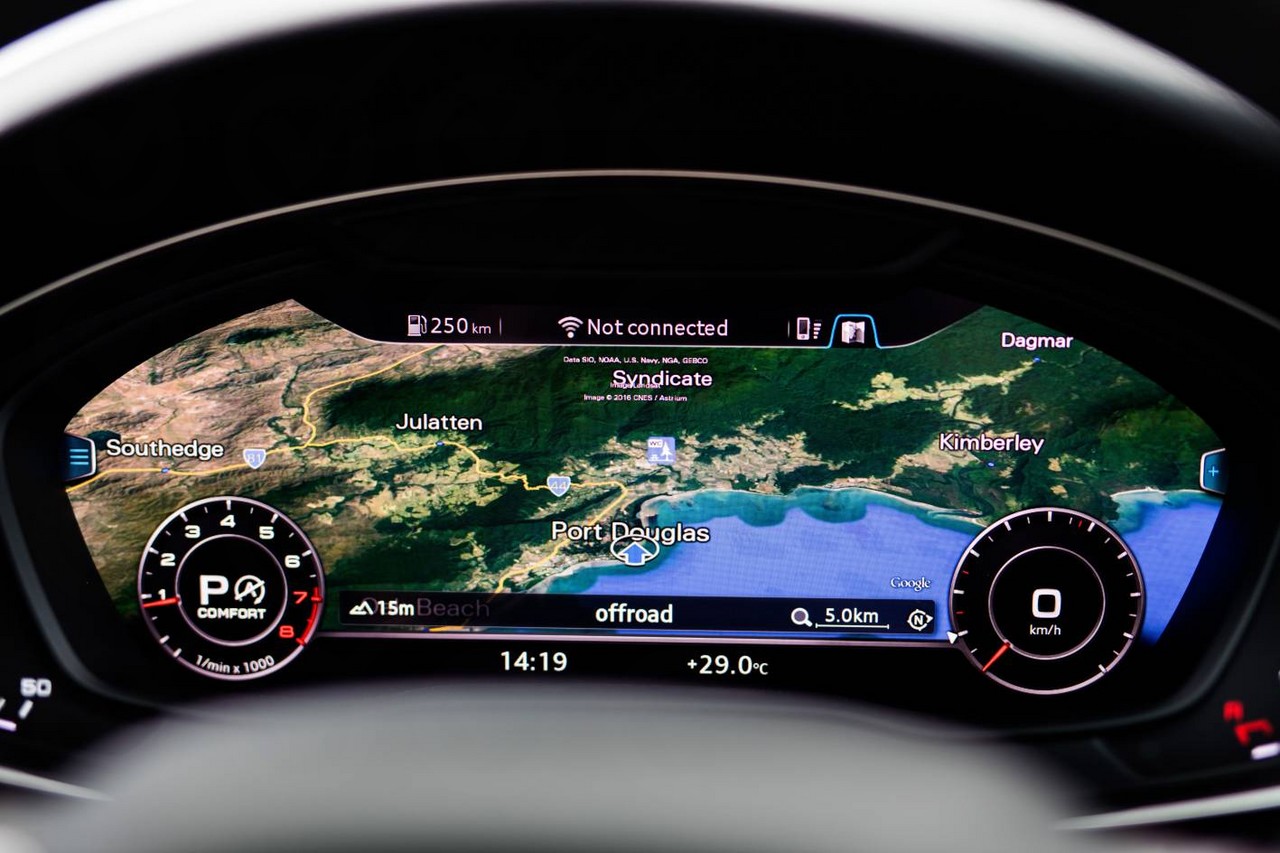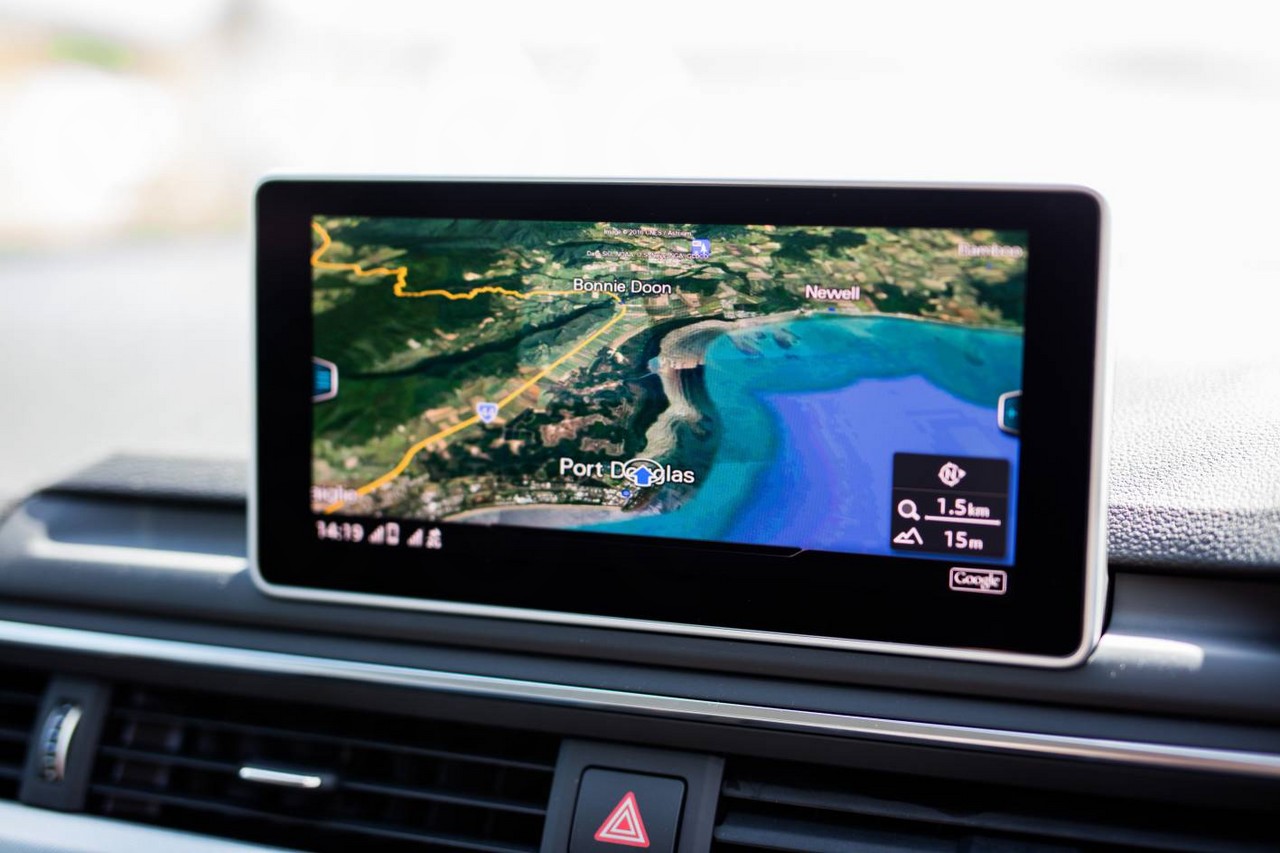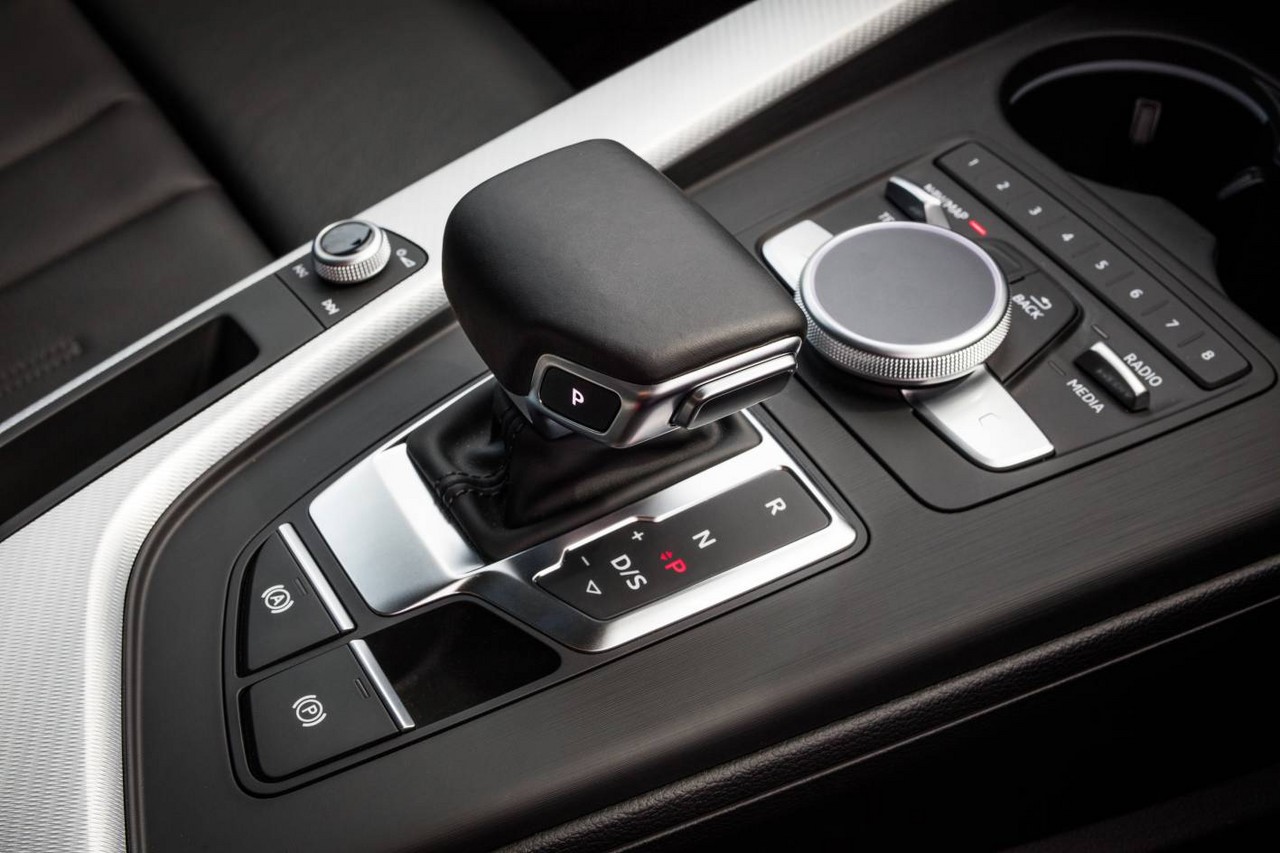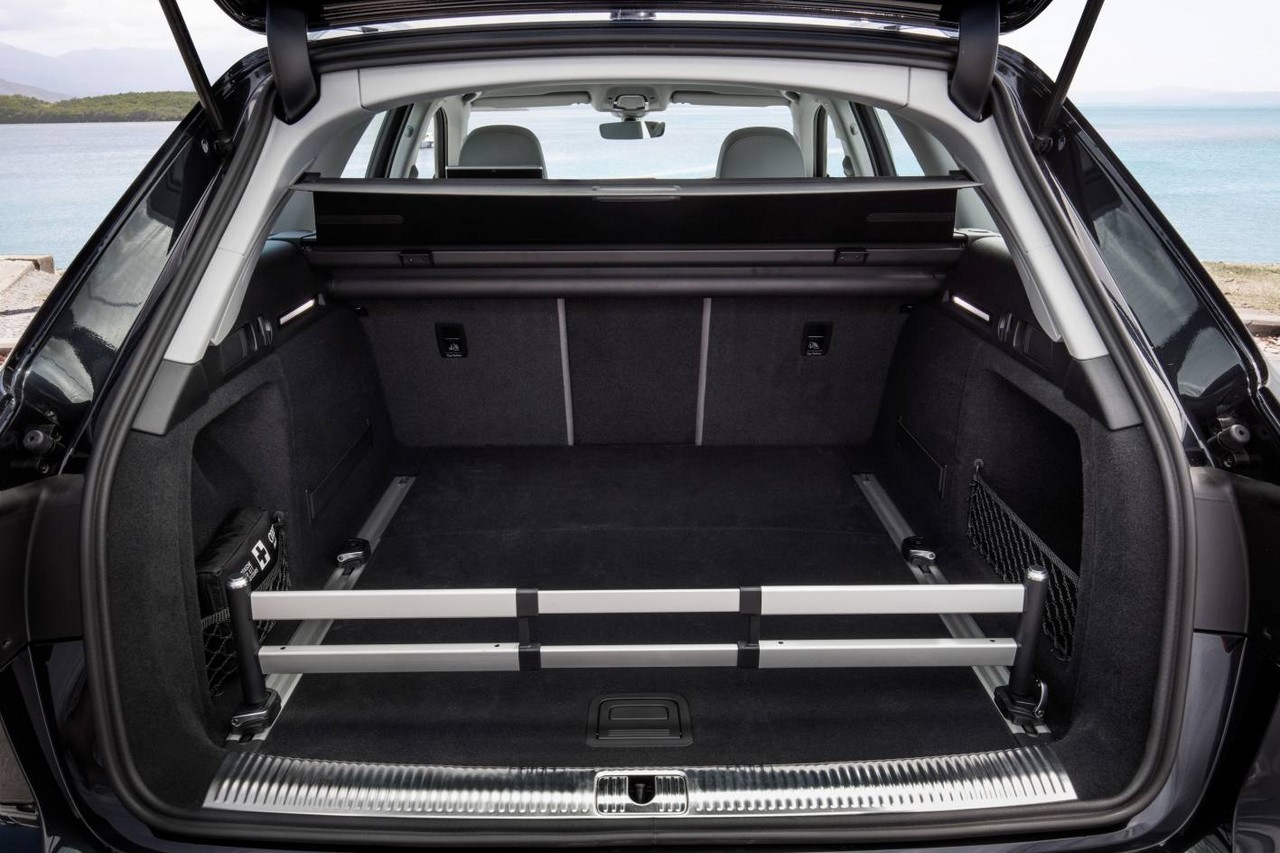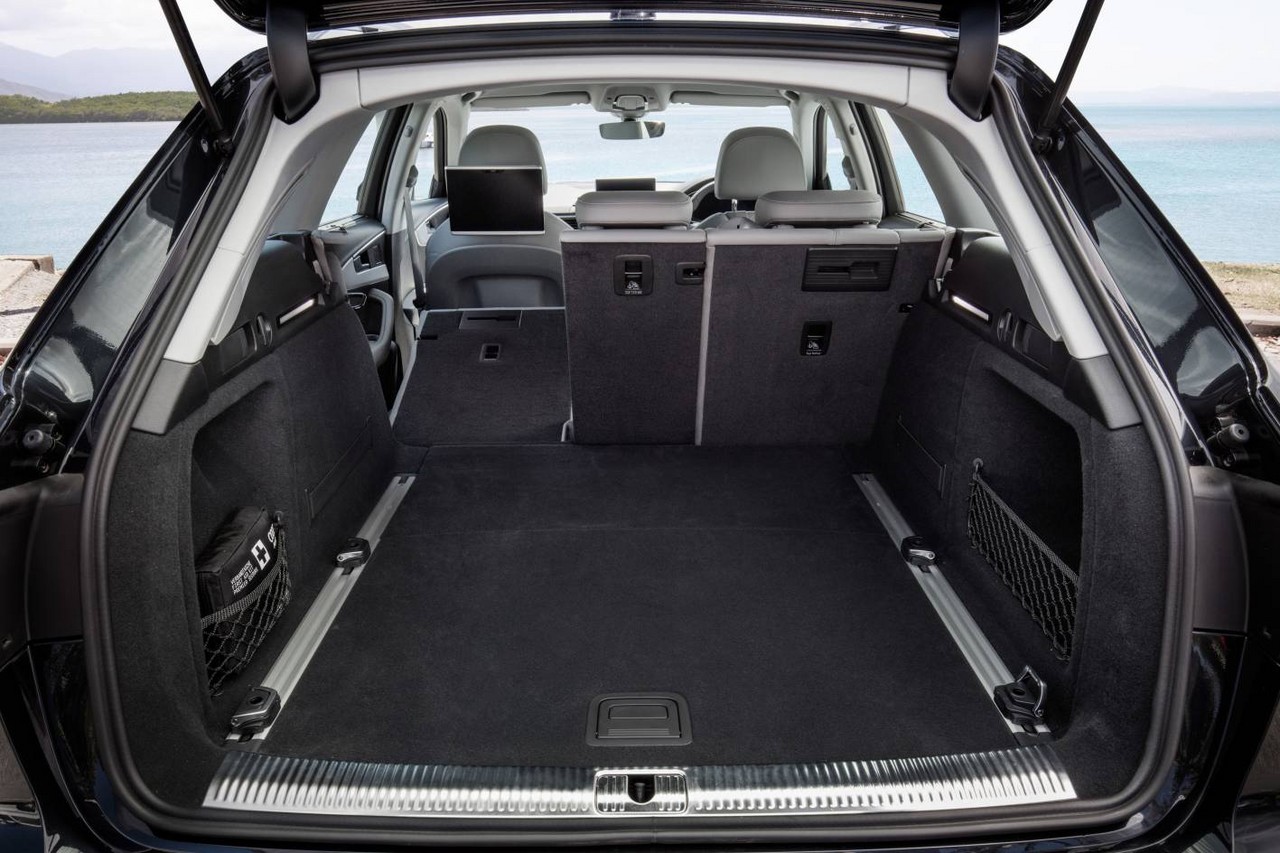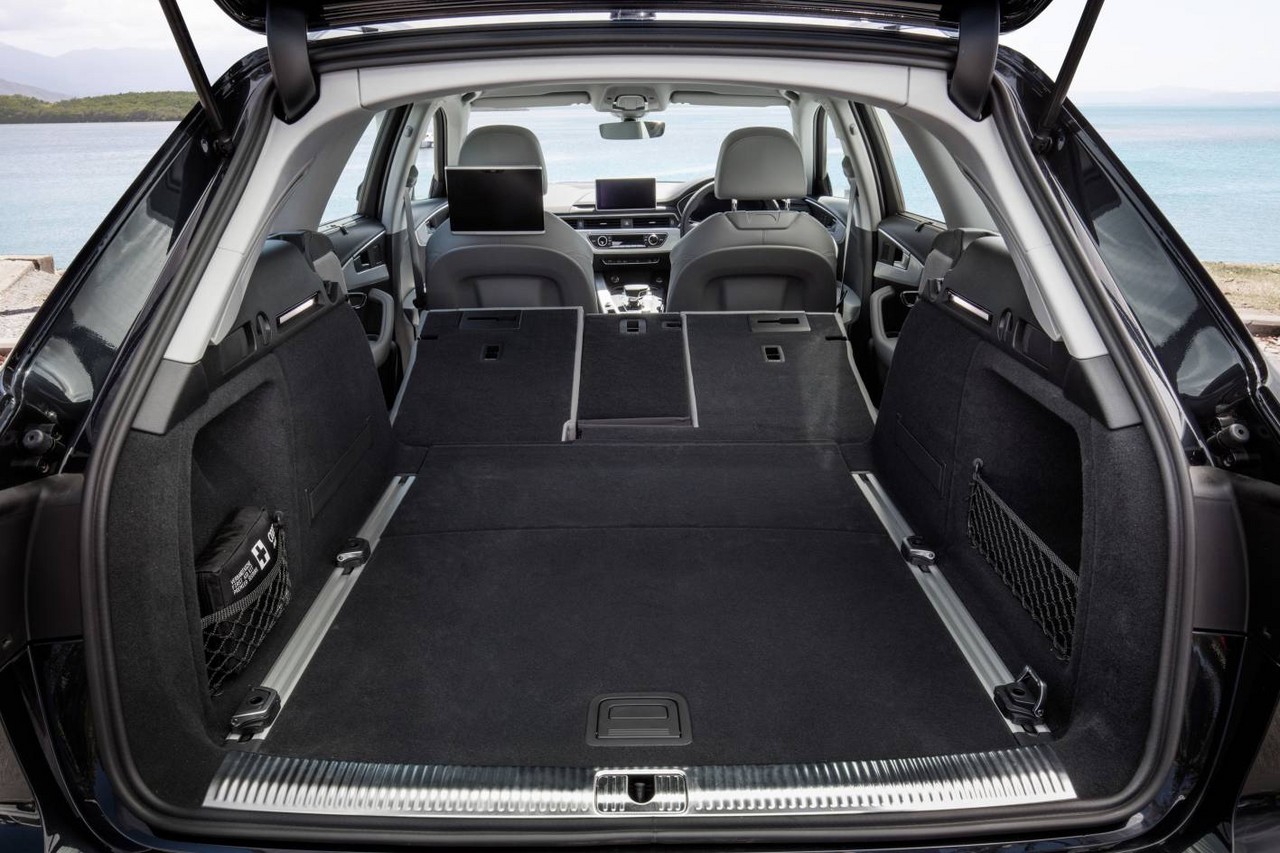
- Responsive 2.0-litre turbo petrol engine
- High standard of interior fit and finish
- Comfortable and supportive front seats
- Longer-travel suspension provides far more comfortable ride than standard Audi B9 A4
- Predictable handling
- Steering is overly assisted at low speeds and around centre, and lacks feedback
- S tronic transmission quick to upshift for fuel economy
- No spare tyre for off-road use
Overview
Officially released in Australia in September 2016, the Audi B9 A4 Allroad quattro was an all-wheel drive wagon. Manufactured in Ingolstadt, Germany, the Audi B9 A4 Allroad quattro was available in 2.0 TDI and 2.0 TFSI variants, both of which had seven-speed double clutch transmissions (Audi’s ‘S tronic’).
To reduce fuel consumption,
- All engines for the Audi B9 A4 allroad quattro had a ‘Start-Stop’ function which enabled them to shut down as the vehicle is coming to rest – this occurred at speeds of 7 km/h; and,
- For models with double-clutch and automatic transmissions, a free-wheel function disengaged the engine from the driveline to reduce engine braking at speeds between 55 km/h and 160 km/h.
The B9 A4 Allroad quattro had a towing capacity of 2100 kilograms at an eight per cent grade.
| Variant | Engine | Trans. | Peak power | Peak torque |
|---|---|---|---|---|
| 2.0 TFSI | 2.0-litre turbo petrol I4 | 7sp DCT | 185 kW at 5000-6000 rpm | 370 Nm at 1600-4500 rpm |
| 2.0 TDI | 2.0-litre turbo-diesel I4 | 7sp DCT | 140 kW at 3800-4200 rpm | 400 Nm at 1750-3000 rpm |
quattro four-wheel drive system
The four-wheel drive ‘quattro’ system for the B9 A4 Allroad quattro was a purely mechanical system which utilised a self-locking central differential (designed as a planetary gear train). In normal conditions, the differential provided 60 per cent of the engine’s torque to the rear axle and 40 per cent to the front, i.e. a 40:60 front:rear torque split. Depending on the situation, however, up to 70 per cent of the engine’s torque could be transferred to the front and up to 85 per cent to the rear.
Body and dimensions
The Audi B9 A4 Allroad quattro shared its underpinnings with the Audi B9 A4 and, relative to the B8 A4 Allroad quattro , had a 15 kg lighter body due to lightweight construction techniques and materials. Visually, the B9 A4 Allroad quattro was differentiated from the B9 A4 by its unique front bumper and air intakes, flared wheel arches (finished in matt structure gray or painted in the body colour), underbody guard and rear diffuser finished in selenite silver, black roof rails and ‘allroad’ badges on the front fenders and tailgate.
Compared to the Audi B8 A4 Allroad quattro , the B9 A4 Allroad quattro was 29 mm longer (at 4750 mm), 1 mm wider (1842 mm), 2 mm lower (1493 mm) and had a 13 mm longer wheelbase (2818 mm). Inside, cargo capacity for the B9 A4 Allroad quattro was 505 litres, though this increased to 1510 litres when the rear seats were folded down and the area was filled to the roof. As an option, the B9 A4 Allroad quattro was available with a cargo rails and a load-securing kit.
Suspension
The Audi B9 A4 allroad quattro had five-link front suspension in which the upper links were integrated into the bodywork and the lower links were attached with rubber mounts to a hybrid steel/aluminium sub-frame. For the five-link rear suspension, the axle was insulated from the body by hydraulically damped axle mounts. To reduce mass, the axle links, pivot bearings and dampers stilts were made of forged aluminium.
Compared to the Audi B9 A4 , the suspension of the B9 A4 Allroad quattro increased its ride height by 23 mm, while the larger wheels provided an additional 34 mm of ground clearance.
As an extra-cost option ($1700 at launch), the B9 A4 Allroad quattro was available with electronically-controlled dampers which used sensors to measure the movement of all four wheels, including lateral and longitudinal acceleration. The dampers could then adapt their response to the road surface conditions and the driving situation.
Steering
The Audi B9 A4 allroad quattro had electromechanical power steering with a ratio of 15.9:1 in which the level of power assistance was inversely proportional to vehicle speed. As an option, the B9 A4 allroad quattro was available with ‘dynamic steering’ which varied its ratio – by up to 100 per cent – according to the vehicle’s speed, steering angle and the mode selected in the ‘Audi drive select driving-dynamics’ system.
Safety equipment
Standard safety equipment for the Audi B9 A4 allroad quattro included dual front airbags, front seat-mounted side airbags, rear side airbags, full-length curtain airbags, ABS, electronic brake force distribution, brake assist, electronic stability control, traction control and front seatbelts with pre-tensioners and load limiters.
As standard, the Audi B9 A4 allroad quattro was fitted with the following technologies –
- Audi pre sense city: operating at speeds up to 85 km/h, Audi pre sense city used a windscreen-mounted front camera to scan the road for other vehicles and pedestrians. If there was a risk of a collision, the driver received a series of warnings. If the driver failed to respond, full braking force would be applied autonomously. At initial speeds of up to 40 km/h, collisions could be prevented; at higher speeds (up to 85 km/h), the severity of the collision would be reduced;
- Audi pre sense basic: initiated occupant protection measures such as tightening the front seatbelts, closing the windows and sunroof (where fitted), and activating the hazard lights when ‘unstable driving conditions’ were detected;
- Audi pre sense rear: could warn of potential collisions from behind, warn following traffic by rapidly flashing the brake lights and activate the ‘Audi pre sense basic’ protection measures described above;
- Audi side assist: operating at speeds above 15 km/h, Audi side assist used two rear radar sensors to monitor traffic up to 70 metres behind the A4. If another vehicle approached quickly or was in the driver’s blind spot, a warning LED in the housing of the appropriate door mirror would illuminate. If the driver activated the indicator to change lanes, the LED would blink rapidly to warn the driver;
- Rear cross-traffic assist: when reversing at low speeds, rear cross-traffic assist used the rear radar sensors to detect approaching traffic. If approaching traffic was detected which may cross the vehicle’s path, the driver received warnings (visual, acoustic and a brief, jolting application of the brakes);
- Exit warning: activated when the vehicle stopped moving, exit warning warned occupants if vehicles were approaching from behind by illuminating red fibre optics in the door-opening mechanism as the doors were opened;
- Multi-collision brake: after a collision, multi-collision brake provided ‘controlled application of the brakes’ to reduce vehicle speed and reduce both the likelihood and severity of subsequent collisions; and,
- Attention assist: monitored driver behaviour and issued a warning if the driver was assessed to be ‘inattentive’.
The Audi B9 A4 allroad quattro also had an ‘active bonnet’ which deployed pyrotechnic charges in the event of a pedestrian collision to raise the height of the bonnet and locks to secure it to provide clearance over ‘hard points’ in the engine bay. In doing so, the likely severity of the pedestrian’s impact was reduced.
Assistance package tour
As an extra-cost option, the Audi B9 A4 allroad quattro could be specified with the ‘Assistance package tour’ which included:
- Audi active lane assist: used the front camera to detect lane markings at speeds of 65 km/h and above. If the Audi A4 approached a lane marking without the driver having previously indicated, the electromechanical steering could provide an adjustment to bring the vehicle back into its lane. Using the MMI system, the driver could determine whether this system should be activated at all times or only before the lane marking is crossed. As an option, the driver could choose to have steering wheel vibrations as a warning signal;
- Adaptive Cruise Control (ACC): using two front radar sensors and the camera, ACC can maintain a specified distance – from five distances – between the A4 and the vehicle ahead. Furthermore, ‘Audi drive select’ can be used to adjust the rate of acceleration and other control dynamics;
- Stop&Go function: an extension of the ACC and limited to models with automatic transmissions, ‘Stop&Go’ operated at speeds of 60 km/h to apply the brakes and bring the vehicle to rest. Once traffic began moving, the Audi A4 will automatically accelerate;
- Turning assist: active at speeds from 2 km/h to 10 km/h, ‘turning assist’ operated once the driver activates the right-hand turn signal (for RHD vehicles) and could monitor oncoming traffic. In hazardous situations, the brakes could be applied to bring the vehicle to rest;
- Audi pre sense front: an extension of ‘Audi pre sense city’, pre sense front operated at speeds up to 250 km/h and could prevent front-to-rear collisions or reduce their severity. In hazardous situations, the driver would receive warnings visual and acoustic warnings to apply the brakes, followed by a brief application of the brakes for a jolting effect to alert the driver. If the driver failed to respond, the A4 allroad quattro would decelerate to the greatest possible extent if the vehicle ahead of it is still moving;
- Collision avoidance assist: activated when the A4 allroad quattro needed to avoid an obstacle to avert a collision. Using data from the front camera, the ACC and radar sensors, ‘avoidance assist’ could calculate the distance of the car ahead, its width and degree of offset. The brakes would be briefly applied to alert the driver of the potential danger and, once the driver started steering, the system would provide ‘support with the necessary lane changes with controlled interventions to the power steering’; and,
- High beam assist: automatically switched between low and high beam headlights for improved visibility, using a sensor to determine when it was safe to do so (i.e. without dazzling other drivers).
Euro NCAP crash testing
In Euro NCAP testing , the related Audi B9 A4 received a five star safety rating which included a 90 per cent adult occupant protection rating and an 87 per cent child occupant protection rating. In the frontal offset test, protection of the driver’s head, thighs and feet were rated as good, though lower leg protection was rated as adequate and chest protection as marginal.
Brakes
The Audi B9 A4 allroad quattro 2.0 TDI had 318 mm by 30 mm ventilated front brake discs and 300 mm by 12 mm solid rear discs. The A4 allroad quattro 2.0 TFSI, however, had 338 mm by 30 mm ventilated front brake discs and 330 mm by 22 mm ventilated rear discs.
Features: Audi B9 A4 allroad quattro
Standard features for the Audi B9 A4 allroad quattro included 7.5J x 18-inch alloy wheels with 245/45 R18 tyres, a 180 watt sound system with ten speakers and a six-channel amplifier, Audi’s ‘MMI navigation plus with MMI touch’ which included an 8.3-inch high resolution display, navigation system, integrated voice control, radio with digital tuner (DAB+), CD/DVD player, two USB inputs, two SDXC card readers, an auxiliary input socket (3.5 mm), 10 GB flash memory and Bluetooth interface with music streaming, ‘Audi connect’ (included an in-car Wi-Fi hotspot and Google services), Audi smartphone interface for Apple or Android smartphone integration, power adjustable front sports seats with driver’s seat memory settings, leather appointed seat trim, three-zone climate control air conditioning, LED headlights, LED daytime running lights, dusk-sensing headlights, rain-sensing wipers, a leather steering wheel with gearshift paddles, 40:20:40 split folding rear seats, remote central locking with proximity key, power adjustable and heated mirrors with memory settings and kerb-side view for the passenger side, auto-dimming side and interior rear-view mirrors, power windows, a height and reach adjustable steering wheel, push-button start, roof rails, tyre pressure loss indicator, a power-operated cargo cover and tailgate (with motion detection), map lights, ambient lighting, floor mats, manual rear window sunblinds, a trip computer and an immobiliser.
The Audi A4 allroad quattro was also equipped with the ‘Audi parking system plus front and rear’ which consisted of front and rear parking sensors, a rear view camera and visual display.
Rather than a spare tyre, the B9 A4 allroad quattro was fitted with a tyre repair kit as standard.
Options: Audi B9 A4 allroad quattro
Extra-cost options for the Audi B9 A4 allroad quattro included:
- The Audi virtual cockpit (instrument cluster) which featured a 12.3-inch LCD monitor with a resolution of 1440 x 540 pixels;
- A 755 watt Bang & Olufsen Sound System with 3D sound, including a 16-channel amplifier and 19 loudspeakers; and,
- Matrix LED headlights which contain twelve LEDs with three reflectors. Using data from the front camera, the control unit switches the LEDs on or off as required, providing 64 different levels of lighting. Using information from the optional MMI Navigation plus system, the direction of the matrix LED headlights could also change before the steering wheel turned.
Brochure and specifications
Related links
